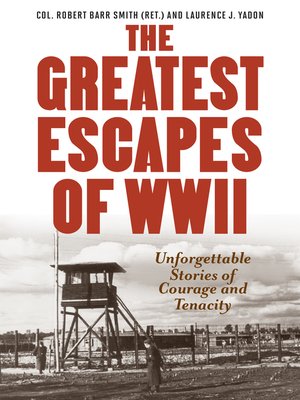
Sign up to save your library
With an OverDrive account, you can save your favorite libraries for at-a-glance information about availability. Find out more about OverDrive accounts.
Find this title in Libby, the library reading app by OverDrive.



Search for a digital library with this title
Title found at these libraries:
| Library Name | Distance |
|---|---|
| Loading... |
Throughout WWII, thousands of Allied prisoners dreamed of outwitting their captors and returning to war against the Axis. Their ingenuity knew no bounds: they went over the barbed wire surrounding them and under it as well; they built tunnels of enormous length and complexity, often working with only their bare hands. They concealed themselves in their captors' vehicles and hitched rides to freedom. They became world-class forgers and tailors; they stole anything that might be useful to their escapes that wasn't actually red-hot or nailed down.
Some of them made it to freedom; some did not. Many of those who failed simply tried again and again until they succeeded. Some of the escapers who were caught were murdered by the Japanese or the German Gestapo. That did not stop others from risking torture or death to gain their freedom. Many men whose break was initially successful would not have survived save for the dangerous, selfless help of civilians, especially in occupied Europe and the Philippine Islands.
The stories in The Greatest Escapes of WWII highlight the courage, endurance, and ingenuity of Allied prisoners, chronicling their ceaseless efforts and the alarm that spread far and wide when one or more escaped. These escapes tied up thousands of Axis soldiers who might otherwise have prolonged the war for many more bloody months. The troops committed to guard the Allied prisoners and recapture escapers numbered in the hundreds of thousands.
Some of them made it to freedom; some did not. Many of those who failed simply tried again and again until they succeeded. Some of the escapers who were caught were murdered by the Japanese or the German Gestapo. That did not stop others from risking torture or death to gain their freedom. Many men whose break was initially successful would not have survived save for the dangerous, selfless help of civilians, especially in occupied Europe and the Philippine Islands.
The stories in The Greatest Escapes of WWII highlight the courage, endurance, and ingenuity of Allied prisoners, chronicling their ceaseless efforts and the alarm that spread far and wide when one or more escaped. These escapes tied up thousands of Axis soldiers who might otherwise have prolonged the war for many more bloody months. The troops committed to guard the Allied prisoners and recapture escapers numbered in the hundreds of thousands.







